Introduction
API testing is a vital activity in software development that ensures the robustness of application programming interfaces. As our digital ecosystem becomes more complex, the role of APIs becomes more central, acting as the linchpins that hold our digital experiences together.
This article covers various aspects of API testing, including best practices, creating a dedicated testing environment, automating API tests, running tests throughout the API lifecycle, writing reusable subtests, documenting API requests, API security testing, and using tools like Postman and Playwright for API testing. By leveraging these techniques and tools, developers can achieve maximum efficiency and productivity in their API testing efforts.
What is API Testing?
API testing is a vital activity in the realm of software development, where the robustness of application programming interfaces is scrutinized. This rigorous process entails sending a variety of requests to the API and critically assessing the responses.
The goal is to validate that the API performs as anticipated, a non-negotiable for maintaining the excellence of both the APIs and the applications that depend on them. As our digital ecosystem grows increasingly complex, the role of APIs becomes more central, acting as the linchpins that hold our digital experiences together.
Yet, these critical components are not free from the need for regular checks to ensure their stability and security. The frequency of these evaluations, or the testing cycle, can be tailored to the specific needs and circumstances of the software, reflecting the dynamic nature of technological advancement. Software testing as a whole, which API testing is a part of, works to uncover discrepancies between expected and actual outcomes, seeking to identify anything from minor bugs to severe logical errors before they can evolve into larger issues. This is not just about fixing errors; it's an investment in the software's quality and reliability, aimed at preempting failures and ensuring seamless functionality.
API Testing Best Practices
Mastering API testing is pivotal in today's digital ecosystem, where APIs are the linchpins of our digital conveniences. To conduct thorough and effective API testing, one must immerse in the API specifications, fully grasping the requirements. Crafting well-defined test cases and employing diverse test datasets to mimic a spectrum of scenarios is imperative.
Embracing automation for API tests not only streamlines the process but also ensures consistency in testing various input types and parameters. An exhaustive approach to testing should encompass functional, performance, and security assessments. Robust assertions are crucial to confirm that the API responses align with expected outcomes.
Ongoing monitoring and analysis of API performance are vital to preempt issues and enhance service reliability. Collaborating closely with developers and stakeholders is essential to align the testing objectives and outcomes, thereby fortifying the API's stability and security. Such diligent practices in API testing are indispensable for maintaining the seamless operation of these critical digital interfaces.
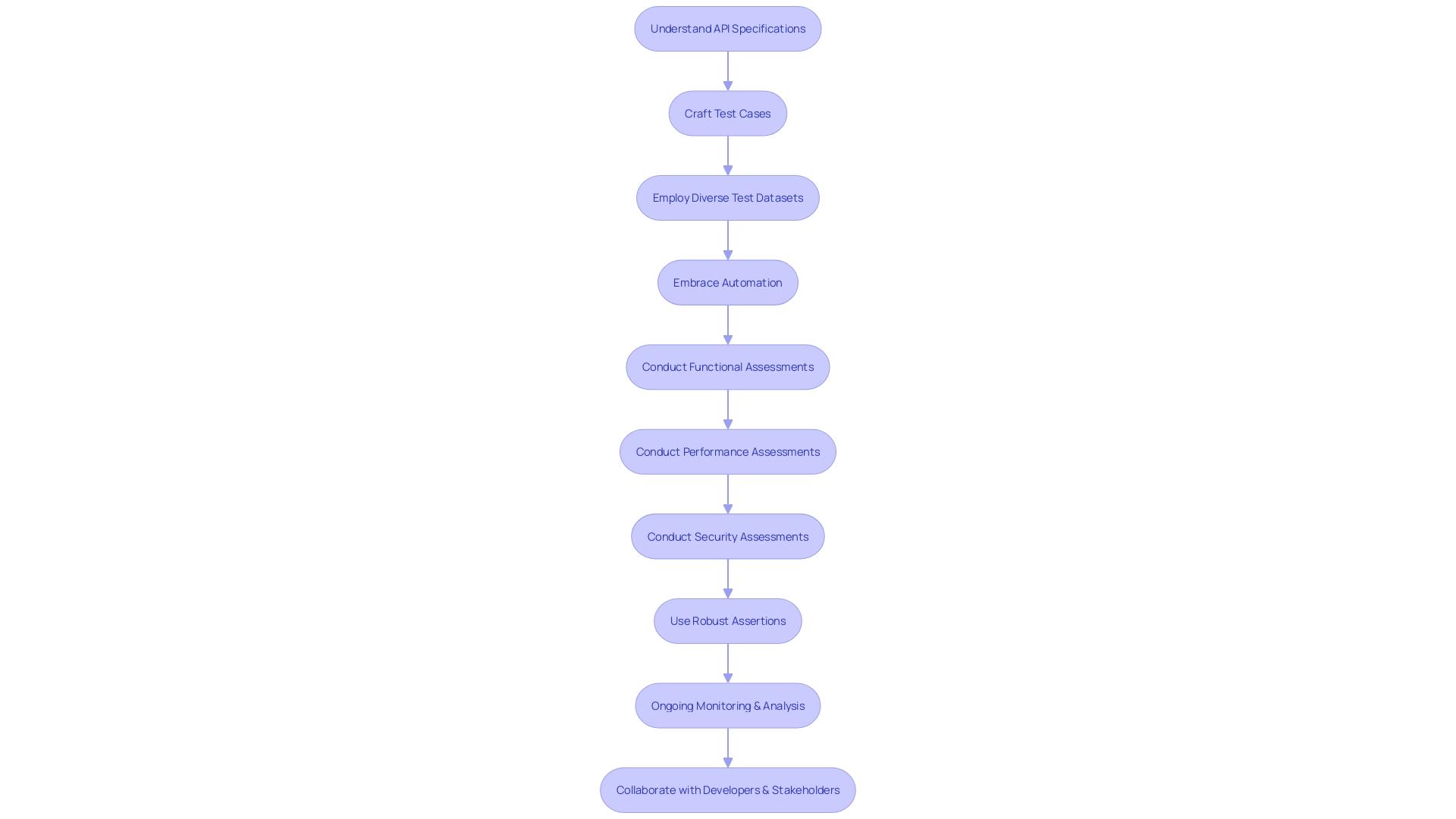
Creating a Dedicated Testing Environment
When embarking on API testing, a structured approach is key to ensuring the functionality and security of these vital components in software development. The initial step is to establish a testing environment that mirrors the production setting while providing a controlled space for testing.
This involves provisioning a server or virtual machine specifically for this purpose. Once the server is set up, it's crucial to equip it with the required tools and dependencies that are present in the production environment.
This alignment between the two environments can significantly aid in reducing discrepancies and unexpected behaviors when deploying to production. The management of test data and configurations is efficiently handled through version control systems, which not only track changes but also allow for the rollback to previous states if needed.
Security protocols are paramount in this setup to safeguard sensitive information from unauthorized access. Additionally, implementing robust monitoring and logging systems not only aids in real-time issue detection but also provides valuable insights into the performance and stability of the APIs during testing. With APIs hailed as the 'crown jewel of software development' by Google, and their increasing importance in fostering innovation and collaboration across industries, it's clear that a dedicated testing environment is not just a good practice but a necessity. This environment becomes a pivotal part of the development lifecycle, allowing teams to detect and address issues early, thereby enhancing the reliability and security of the APIs they develop.
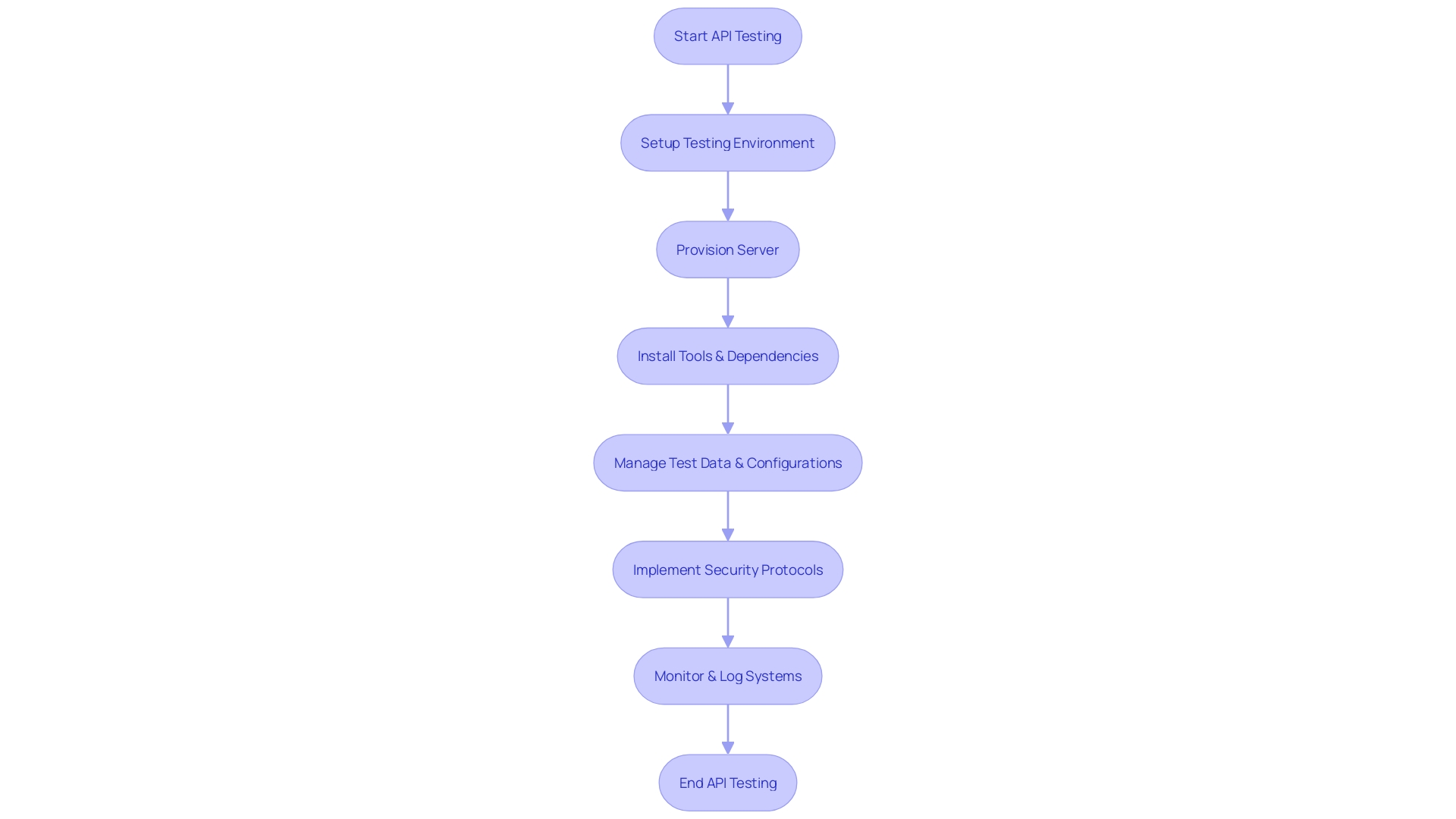
Automating API Tests
Automation plays a vital role in mastering API testing. It allows you to save time and effort by automating repetitive tasks and executing tests quickly. Here are some steps to automate API tests:1.
Select an appropriate API testing framework or tools. Identify the test scenarios that are suitable for automation. Write test scripts using the chosen framework or tool.
Integrate the test scripts into your continuous integration/continuous delivery (CI/CD) pipeline. Set up test data and configurations for automation. Execute the automated tests and analyze the results By automating API tests, you can achieve faster test execution, improve test coverage, and identify issues early in the development process.
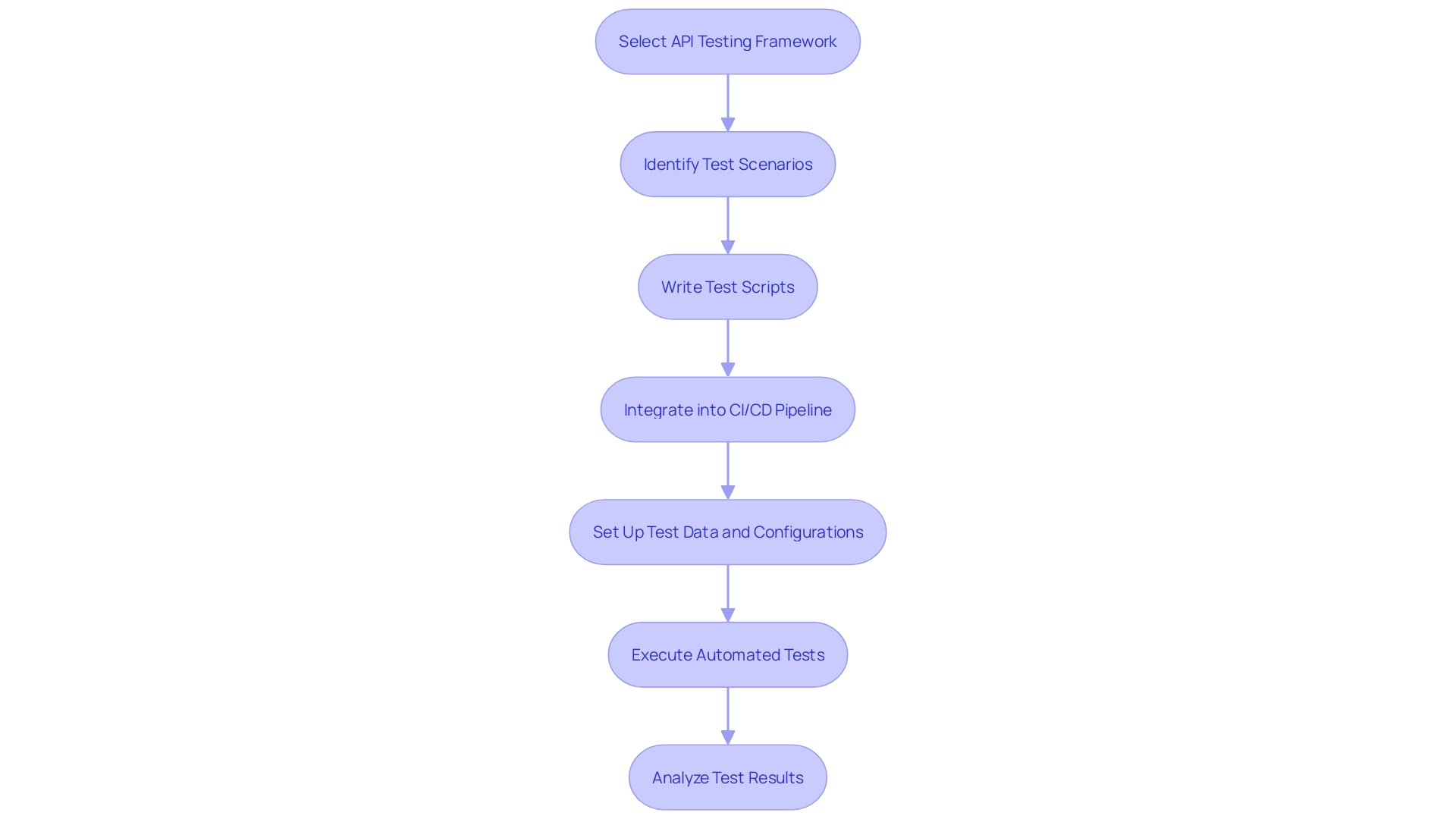
Running Tests Throughout the API Lifecycle
API testing is an integral part of software development, serving as the backbone for verifying the functionality, reliability, and security of APIs at every stage of the lifecycle. With the digital world heavily relying on these interfaces, regular testing is not just recommended but essential. Here's a structured approach to API testing across its lifecycle:
Unit Testing: Begin with the basics by testing individual API components. This is the most granular level of testing, where each function is verified for accuracy. Unit tests are concise, quick, and set the foundation for subsequent tests.
-
Integration Testing: Next, assess how well your API plays with others. This involves testing the interactions between various APIs or modules to ensure seamless communication and function.
-
System Testing: Take a step back and look at the bigger picture by testing the entire system or application that incorporates the APIs. This holistic approach ensures that all components work harmoniously.
-
Performance Testing: Push your APIs to their limits to evaluate performance under varied load conditions. This is critical for understanding how your APIs will behave under stress.
-
Security Testing: With cyber threats on the rise, rigorously test your APIs for any security loopholes to protect data and maintain user trust. 6.
Regression Testing: Finally, ensure that any changes or updates haven't disturbed the existing functionality by performing regression tests. Incorporating these testing stages can preemptively catch issues, leading to a more stable and dependable API. As one expert puts it, starting with unit tests is advisable for those new to testing due to their simplicity and ease of interpretation.
Furthermore, defining clear test cases, as mentioned in a recent article, is crucial for verifying that software operates as intended. Software testing not only detects errors early but also saves costs and assures quality, as indicated by statistics highlighting the importance of tailored testing plans and scripts for different software types. Thus, by meticulously planning and executing tests, one can ensure their APIs meet the high standards required in today's digital age.
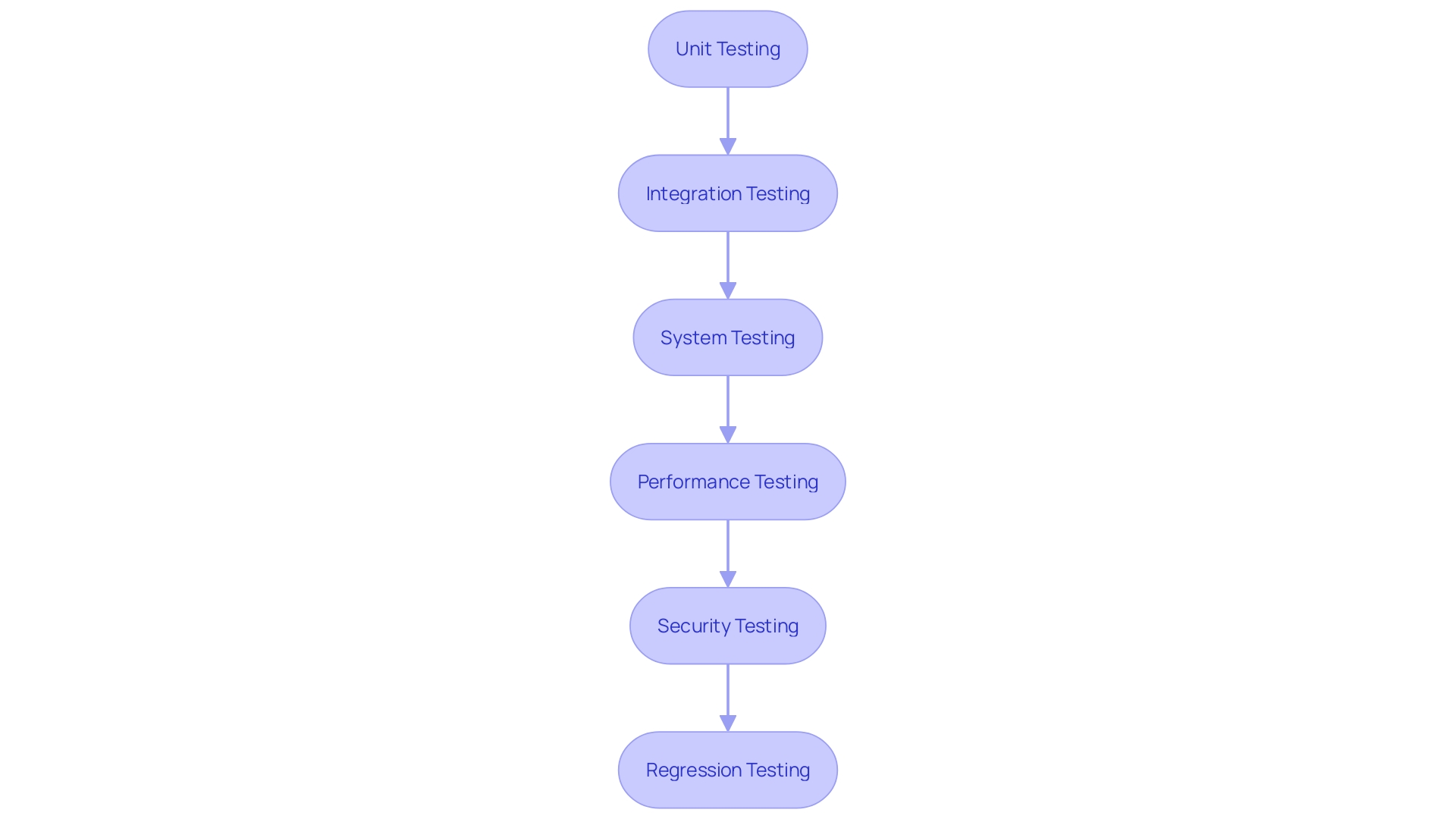
Writing Reusable Subtests
Unit testing stands as a cornerstone of software development, ensuring that each component of your application performs as intended. By writing reusable subtests, developers can elevate the efficiency of this process. These subtests, small and modular in nature, serve as building blocks for crafting complex test scenarios.
Their reusability translates into significant time savings, as they can be applied across numerous test cases. Moreover, the maintainability of your codebase improves, as any modifications to a subtest ripple through all instances of its use. When scaling up to test intricate interactions, subtests are invaluable.
They enable the assembly of larger test scenarios without sacrificing clarity. In fact, they enhance it, presenting a well-organized suite of tests that are easier to navigate and comprehend. This clarity is not just a matter of aesthetics; as Markos Fragkakis, a Staff Engineer at Workable, suggests, it is a reflection of a mindset that embraces separation of concerns, a principle vital for testable, high-quality code.
In the realm of unit testing, where the objective is to isolate and validate code segments, the modularity and independence of subtests play a pivotal role. As Fragkakis's experience with Workable's Applicant Tracking System reveals, adopting such strategies can lead to a robust and scalable testing framework that upholds the integrity and reliability of the software. This approach, recommended for both beginners and experienced developers, simplifies the debugging process and provides transparent documentation of software functionality, ultimately leading to a more bug-free product.
Documenting API Requests
To master API testing, impeccable documentation is not just helpful—it's essential. It's the roadmap that guides testers and developers through the intricacies of API specifications, including endpoints, request parameters, and expected responses.
Just as a well-drawn map leads to Goa, thorough API documentation steers users towards successful implementation and troubleshooting. Begin with a consistent format to document requests and responses, ensuring that clarity and simplicity are at the forefront.
Avoid technical jargon, and if used, accompany it with clear explanations. Include practical examples and sample code to cover various request scenarios, illuminating the path for users just as streetlights do on a highway.
Detail the necessary headers, authentication methods, and authorization protocols, providing a complete picture of API interaction requirements. Enumerate supported request methods—GET, POST, PUT, DELETE, etc.—and ensure that the expected response format and status codes are clearly outlined, leaving no stone unturned. Each API endpoint deserves a clear and concise description, serving as signposts that guide the user through your API landscape. In doing so, you craft a comprehensive guide that not only supports accurate and efficient testing but also stands as a pillar of knowledge on how the API functions, which is crucial in today's digital ecosystem. Remember, the goal is to create documentation that not only meets the needs of the present but also accommodates future maintenance and updates, much like a well-maintained road that stands the test of time and traffic.

API Security Testing
To fortify the digital fortresses that are APIs, a meticulous approach to security testing is indispensable. With the digital landscape expanding and the utilization of APIs skyrocketing, the risk of breaches is climbing.
These breaches, often resulting from unauthorized access, can lead to catastrophic leaks of sensitive data. To combat this, one must delve into several critical facets of API security testing:
Authentication and Authorization: It's essential to scrutinize the API's authentication measures like OAuth, API keys, or tokens. Vigilant testing ensures that only users with proper credentials can tap into protected resources.
- Input Validation: To thwart prevalent threats such as SQL injection, XSS, and XXE attacks, rigorous testing of input validation is paramount.
This step is crucial in barricading the API against malicious inputs that could compromise security. 3.
Session Management: The integrity of session management mechanisms is another cornerstone of a secure API. Testing must confirm that sessions are not only managed efficiently but also safeguarded against unauthorized hijacking or leaks.
- Error Handling: The way an API responds to errors can inadvertently reveal sensitive information.
Therefore, testing should involve simulating various error conditions to ensure that the API's responses do not expose any vulnerabilities. 5. Data Protection: Data is the treasure that pirates of the digital world seek. Testing the API's encryption and secure transmission protocols, such as HTTPS, is fundamental in protecting this treasure from falling into the wrong hands. 6. Compliance: Lastly, aligning the API with established security standards and regulations, like the OWASP API Security Top 10, is a testament to its robustness. This adherence is not just about ticking off a checklist; it's about ensuring the API's fortifications are up to the mark. By rigorously testing these areas, one can uncover and mend potential security vulnerabilities, thereby shielding sensitive data and preserving the API's integrity.
Using Postman for API Testing
In the swiftly evolving digital landscape, APIs are the linchpins that connect various services and applications, providing the seamless experience users have come to expect. Their pivotal role extends from the tech industry's infrastructure to the financial sector's transactional capabilities, and even into the healthcare domain where they safeguard patient data.
The API-first strategy, which prioritizes the construction of software as a series of interconnected services via APIs, underscores their significance. This strategy ensures the foundation of applications is robust, secure, and performance-oriented.
Amidst this backdrop, Postman emerges as a formidable ally in API testing and automation. It not only offers an intuitive interface for dispatching and receiving requests to API endpoints but also enables the crafting of JavaScript test scripts to automate and validate tests.
Postman's collections, hailed as the gold standard for API organization, allow for the systematic arrangement of related API elements, facilitating smoother edits, sharing, testing, and reuse. These collections act as organized folders within the workspace, enhancing manageability. Moreover, Postman's capacity to store diverse environments such as development, staging, and production, simplifies the transition between these settings. The platform's collaboration tools further empower teams to share collections, co-develop tests, and monitor modifications in real-time. Leveraging Postman can significantly refine your API testing process, elevating the efficiency of your workflow.
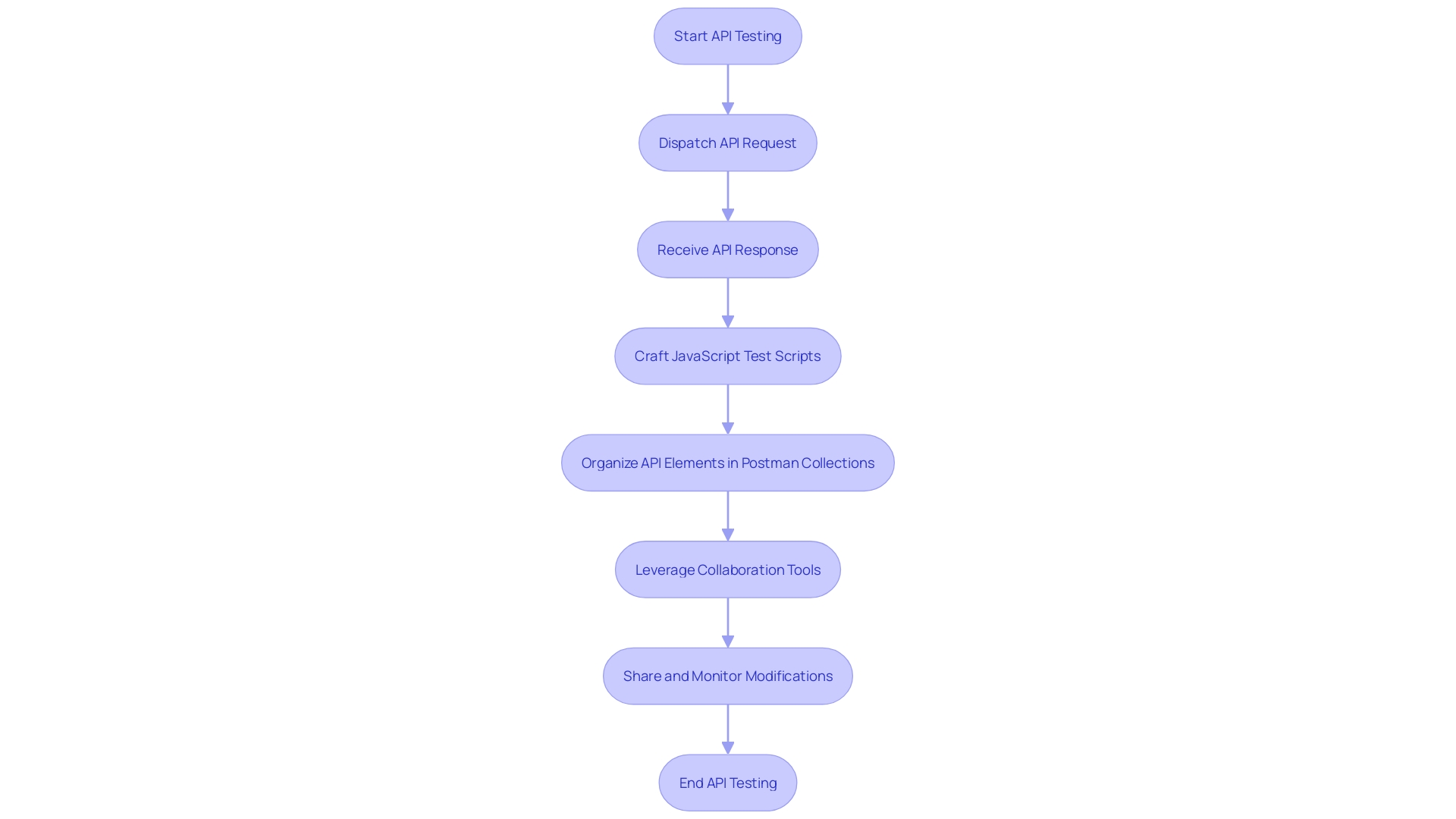
Postman Collections and CLI
Understanding the structure and functionality of Postman collections is crucial for any developer working with APIs. A collection is essentially a folder in which you can group your requests to maintain an organized workspace.
According to Postman's own documentation, collections are considered the 'gold standard for API organization,' enabling you to link related API elements for effortless editing, sharing, testing, and reuse. When you initiate a collection, you're presented with an interface that facilitates the management of your API requests and associated tests.
This level of organization is particularly beneficial when dealing with the extensive use of APIs across various industries—from technology, where APIs serve as the core components of applications, to financial institutions and healthcare providers who depend on APIs for transaction facilitation and secure patient data management, respectively. The API-first strategy, which prioritizes the quality, security, and performance of APIs by designing applications as a series of services delivered through APIs, further underscores the importance of effective API organization. Postman collections, coupled with the command-line interface (CLI), offer a robust solution for integrating API tests into continuous integration/continuous deployment (CI/CD) pipelines, thus enabling automated testing and continuous integration. This integration streamlines the process of running tests in bulk, sharing collections with team members, and ensuring that API development remains a top priority in the software development lifecycle.
Automating API Tests with Postman CLI
To enhance your development and deployment workflows with automated API testing, the Postman command-line interface (CLI) is an invaluable tool. Start by installing the Postman CLI, which will enable you to leverage the powerful features of Postman Collections.
These collections are more than just folders; they're a robust method for organizing API elements that allow for efficient editing, sharing, testing, and reuse. Once you've installed the CLI, export your Postman collection—as described by Postman documentation, these collections are the gold standard for API organization—into a JSON file.
This file will serve as the blueprint for your automated tests. Next, craft a script or tweak your continuous integration and continuous deployment (CI/CD) pipeline to incorporate Postman CLI commands.
Executing these commands initiates your API tests and generates comprehensive reports. With APIs being fundamental to applications across various industries, from finance to healthcare, ensuring their reliability through thorough testing is essential. An API-first strategy prioritizes the quality, security, and performance of these APIs, which is where the Postman CLI comes into play. By integrating the CLI commands into your CI/CD pipeline, you make API testing a seamless part of your development process, thus reinforcing the stability and reliability of your applications.
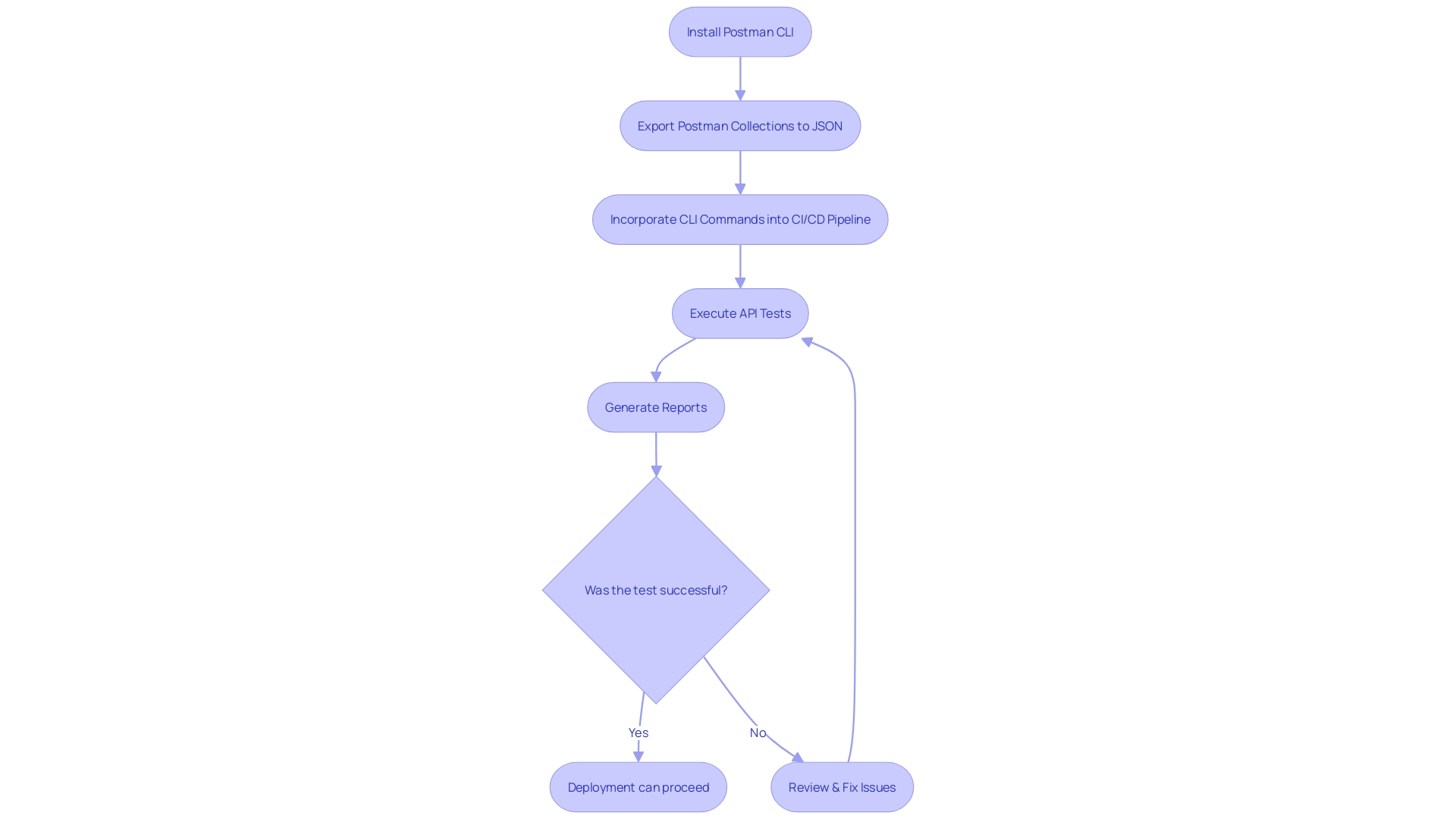
API Testing with Playwright
When it comes to API test automation, Playwright emerges as a standout choice for developers aiming to streamline their workflows. Its cross-browser compatibility is a game-changer, enabling testing across a variety of browser environments, which is critical given the diverse web ecosystem. Notably, Playwright's support extends beyond just JavaScript, embracing languages such as Python and C# as well, thus accommodating a broader range of developers.
The framework's robust automation capabilities are particularly noteworthy; it adeptly handles tasks like cookie management, screenshot captures, and network request mocking, which are indispensable for thorough testing. Perhaps one of the most compelling features of Playwright is its ability to execute tests in parallel, considerably speeding up the testing process. This aspect is particularly beneficial for Quality Specialists, like Kostiantyn, who face the challenge of repetitive API testing with each new release.
By leveraging Playwright's progressive features, repetitive testing tasks become more manageable and less time-consuming. This not only optimizes the development cycle but also ensures a high level of quality within platform improvements. The decision to adopt Playwright is backed by its growing popularity within the Node.js community, which speaks volumes about its effectiveness and the value it brings to developers.
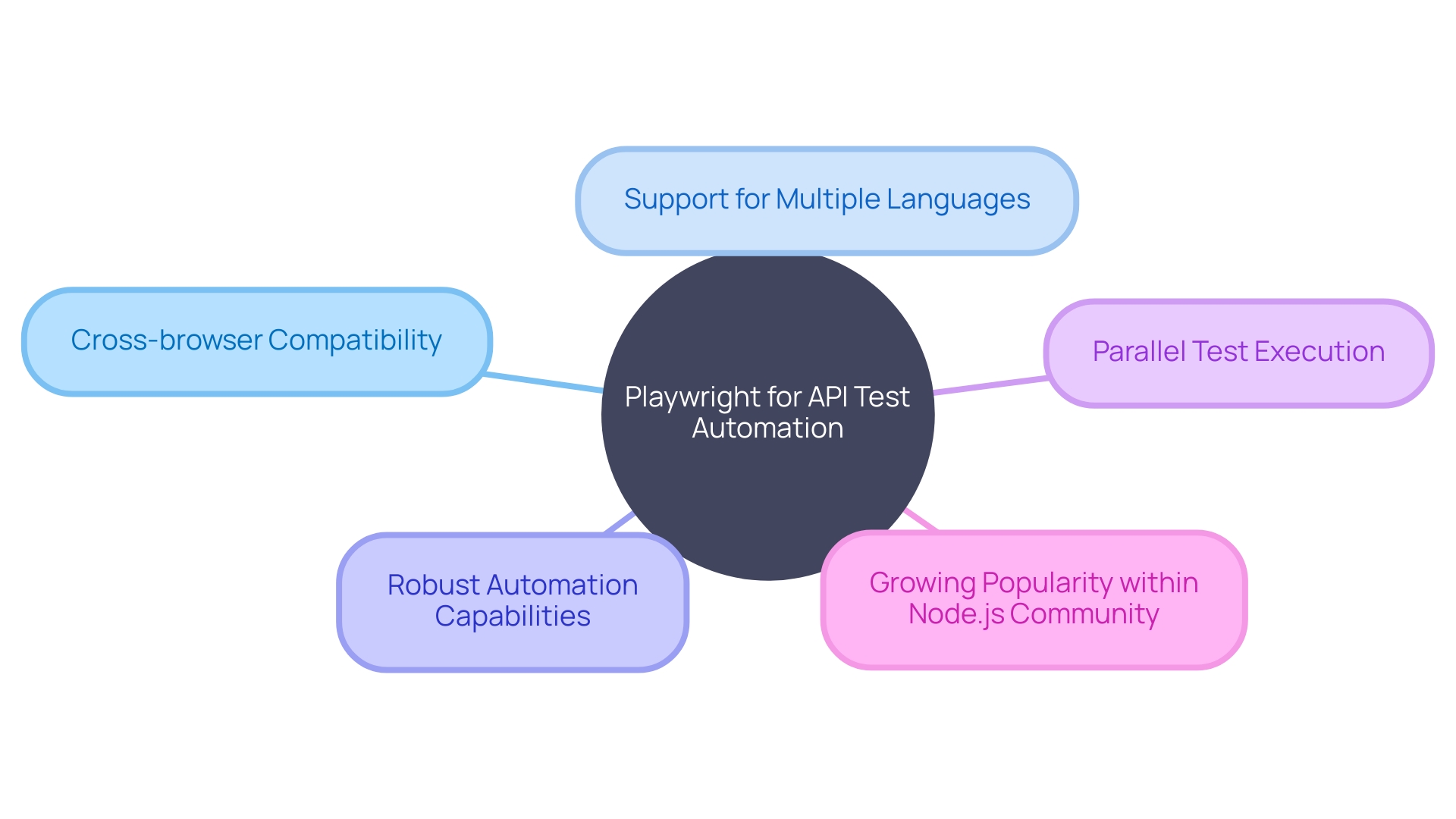
Conclusion
In conclusion, API testing is essential in software development to ensure the robustness of application programming interfaces. By following best practices, creating a dedicated testing environment, automating tests, running tests throughout the API lifecycle, writing reusable subtests, documenting API requests, and conducting security testing, developers can achieve maximum efficiency and productivity.
A dedicated testing environment mirrors the production setting and reduces discrepancies during deployment. Automation streamlines the testing process and improves test coverage.
Running tests throughout the API lifecycle verifies functionality, reliability, and security at every stage. Writing reusable subtests saves time and enhances maintainability.
Impeccable documentation guides testers and developers through API specifications. API security testing is indispensable to protect against breaches and unauthorized access.
Tools like Postman offer an intuitive interface for sending requests to API endpoints and automating tests. Playwright's cross-browser compatibility and robust automation capabilities optimize workflows. By leveraging these techniques and tools, developers ensure the excellence of their APIs. The benefits include faster test execution, improved test coverage, early issue identification, enhanced reliability and security, time savings through automation, efficient use of resources with reusable subtests, comprehensive documentation for accurate testing, and fortification against breaches with robust security testing. Investing in API testing is crucial in today's digital age where APIs serve as linchpins that hold our digital experiences together. By prioritizing API testing with these techniques and tools, developers can build robust applications that meet the high standards required in today's complex digital ecosystem.
Frequently Asked Questions
What is API Testing?
API testing is a crucial part of software development that focuses on evaluating the functionality, reliability, and security of application programming interfaces (APIs). It involves sending various requests to the API and analyzing the responses to ensure they meet expected outcomes.
Why is API Testing Important?
API testing is essential to maintain the quality of both the APIs and the applications that rely on them. It helps identify discrepancies between expected and actual outcomes, uncovering bugs or errors before they escalate into larger issues.
What are the Best Practices for API Testing?
- Understand API Specifications: Grasp the requirements of the API. 2. Define Test Cases: Create detailed test cases using diverse datasets to simulate various scenarios. 3. Automate Testing: Use automation to ensure consistency and efficiency in testing. 4. Conduct Comprehensive Testing: Include functional, performance, and security assessments. 5. Monitor API Performance: Continuously analyze performance to preemptively address issues. 6. Collaborate with Stakeholders: Work closely with developers and other stakeholders to align testing objectives.
How Should a Testing Environment be Set Up?
A dedicated testing environment should mirror the production setting to minimize discrepancies. This includes setting up servers or virtual machines, managing test data with version control systems, and implementing security protocols to protect sensitive information.
How Can API Tests be Automated?
To automate API tests, follow these steps: 1. Select an appropriate API testing framework or tool. 2. Identify test scenarios suitable for automation. 3. Write test scripts using the chosen tool. 4. Integrate scripts into your CI/CD pipeline. 5. Set up test data and execute automated tests.
What is the API Testing Lifecycle?
The API testing lifecycle consists of several stages: 1. Unit Testing: Test individual components for accuracy. 2. Integration Testing: Assess interactions between APIs or modules. 3. System Testing: Evaluate the complete system that includes the APIs. 4. Performance Testing: Test API performance under different load conditions. 5. Security Testing: Identify security vulnerabilities. 6. Regression Testing: Ensure updates do not disrupt existing functionality.
What are Reusable Subtests and Why are They Important?
Reusable subtests are modular components used in unit testing. They save time and enhance maintainability as changes to a subtest propagate across all instances. This modularity simplifies complex test scenarios and improves code clarity.
How Important is Documentation in API Testing?
Documentation is crucial for guiding testers and developers through API specifications. It should be clear, consistent, and include examples to ensure successful implementation and troubleshooting. Proper documentation supports efficient testing and future maintenance.
What are Key Aspects of API Security Testing?
Key areas include: 1. Authentication and Authorization: Ensure only authorized users access protected resources. 2. Input Validation: Protect against threats like SQL injection. 3. Session Management: Safeguard against unauthorized session hijacking. 4. Error Handling: Prevent sensitive information exposure through errors. 5. Data Protection: Test encryption and secure transmission protocols. 6. Compliance: Align with established security standards.
How is Postman Used for API Testing?
Postman provides an intuitive interface for sending requests and receiving responses. It supports automation through JavaScript test scripts and helps organize API elements into collections for easier management and collaboration.
What Role Does Playwright Play in API Testing?
Playwright allows cross-browser testing and supports multiple programming languages. Its robust automation capabilities, including parallel test execution, make it efficient for repetitive API testing tasks, ensuring high quality in platform improvements.




